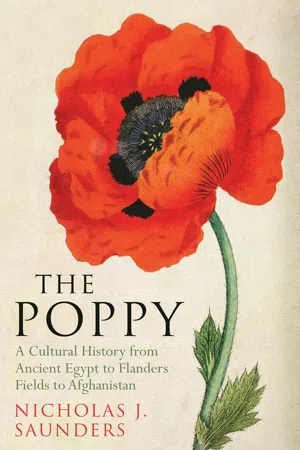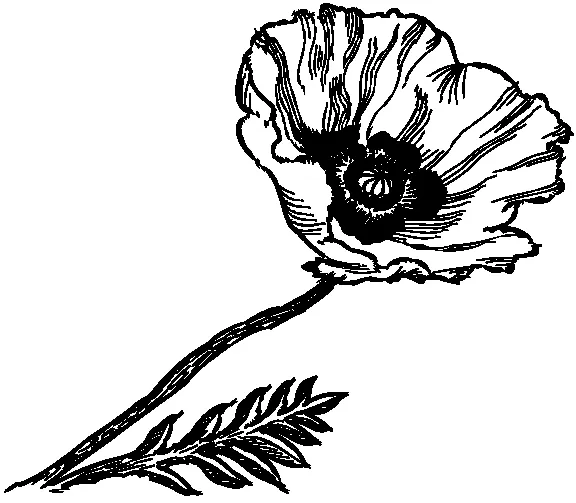1
Genesis
The Eurostar hurtles down the high-speed rail track that cuts through the French countryside from the port of Calais to the medieval city of Lille. For a moment, a scarlet blur fills the carriage windows, and is then pushed back by a fence of barbless wire. This is the largest war memorial the world has seen – a hundred million poppies straddling the railway and A1 motorway as they make their way south from the English Channel into the heart of northern France. Yet it is a figment of the imagination.
The memorial lives only as a proposal suggested in 1999 by Pascal Truffaut, a professor of architecture from Lille. His knowledge of the First World War and his professional expertise moved him to imagine something unique, something that would vividly commemorate the tens of thousands who died on the battlefield of the Somme in the summer of 1916, exactly the time of year when poppies appear. Crimson poppies would make a striking monument, Truffaut says, ‘they should form a “river of blood”, a permanent reminder of the sacrifice, and the horrors, of the war, for all the nations who were involved’.1
Truffaut’s ribbon of red was planned to follow part of No Man’s Land, the killing ground which divided the opposing Allied and German trenches. It was just to the north of here, at Ypres in Belgian Flanders, that John McCrae, a Canadian army doctor, wrote the poem ‘In Flanders Fields’ that ignited the passions of the postwar public and launched the very first Remembrance Poppy appeal. McCrae’s poem has itself become the enduring memorial to the Great War.
It was May 1915. A few days earlier, the Germans had unleashed a choking fog of chlorine gas onto the Allied positions and McCrae had read the Order for the Burial of the Dead over the freshly dug grave of his friend Lieutenant Alexis Helmer. Blown to pieces by a bombardment just hours before, twenty-two-year-old Helmer was hurriedly buried in an impromptu battlefield cemetery, yards from the first-aid dugout where McCrae tended the wounded. At dawn the next day, McCrae gazed on the makeshift burials of those who had been killed, and noted the lively corn poppies that had sprung up between them. The scene played on his mind. Glancing occasionally at Helmer’s grave, he immortalised the poppy in verse.
McCrae’s poem caused a sensation on its publication. The corn poppy was rechristened the Flanders Poppy, and the image of its fragile blood-red petals rooted itself in the psyche of the English-speaking Allies as their emblem of remembrance. The poem and the poppies that inspired it were fused into one, a symbol used to raise money for the war effort, and later for postwar campaigns to honour the dead and to help those maimed by the war: the Remembrance Poppy.2
Tragic yet uplifting, lethal but comforting, the story of the Remembrance Poppy is international in spirit yet intimately personal. As a symbol the poppy has an ancient and fractured past, but this history has not prevented it from taking on new and contorted meanings in our modern commercial age. Over the last century, the flower became inseparable from our experience of countless conflicts, from the Great War through the Second World War to Iraq. Today it is embroiled in a new struggle – called until recently the ‘War on Terror’ – a seemingly unending state of conflict enlisting the men and women of our volunteer military, whether they are serving in the opium fields of Afghanistan or closer to home. The Remembrance Poppy is a touchstone for the issues and the aftermath of these wars – the value put on the sacrifice made by millions of dead, the place of pacifism, the importance of public remembrance, the billion-dollar trade in narcotics trafficking and the multi-billion-dollar business of war. The Remembrance Poppy is volatile, for ever entangled with people as they endure the chaos of war and then struggle to find some way to rebuild their lives once war has ended.
Of course, the poppy is also a real living thing. Around the world there are about 250 species of poppy, with 70 belonging to the genus Papaver, which takes its name from the Latin for ‘poppy’, and whose members characteristically ooze a creamy latex when cut.3 These poppies range across the alkaline soils of Europe, North Africa and Central Asia. Poppy lives are brief, and they flourish in human company. The origins of the Remembrance Poppy are found in two of myriad species – the simple corn poppy and its powerful cousin, the opium poppy.
Despite the fact that the Remembrance Poppy itself was only conceived in the early part of the twentieth century, the red corn poppy and the pinkish-white opium poppy have had interwoven histories for centuries. They are the poppies of war. Both grow on sunlit, broken ground, and for millennia have inhabited the places where humans till the soil and bury their dead. The corn poppy (Papaver rhoeas) grew with abandon across Europe and the Middle East as trade wars gave way to the Crusades, which in turn gave way to the resource wars of nation states. The painkilling properties of opium have been highly valued as a powerful antidote to the traumas of battle throughout the ages. Long before the advent of modern medicine the opium poppy’s (Papaver somniferum) juice and resin have been used to ease mental anguish and alleviate the pain of wounds. The opium poppy’s soporific qualities brought temporary forgetfulness of suffering to those maimed and bereaved by conflict. Once John McCrae’s poem claimed the corn poppy as the flower of remembrance, the fragile bloom was transformed. But while the Remembrance Poppy took on the corn poppy’s appearance, its power to help individuals bear the pain of suffering and loss, and to continue with their lives despite it all, belong more to the realm of the opium poppy. Ancient traditions collided with modern events, and the two poppy species became one.
The corn poppy’s affair with cultivated land is absolute. As long as the ground is broken, the scarlet flower will grow. Despite its apparent fragility, it is resilient, and possesses all the characteristics of a successful weed. It appears in late spring, as the warming land shrugs off the winter cold; it blooms in early summer, and its heavy, seed-filled pod weighs down the stem as the flower matures, bowing the four-petalled head. When ripe, the star-shaped top of the elongated oval pod explodes, casting thousands of black seeds to the wind, guaranteeing that new poppies sprout in the same fields year after year. The poppy contains a milky sap, whose alkaloid rhoeadine acts as a sedative, and has been used in folk medicine from ancient to modern times to make a mildly soporific tea. When crushed, the seeds yield nutritious oil, a tasty substitute for olive oil. Sunlight glimmers through its short-lived petals, which are silky to the touch and easily bruised. They provide the blush for a deep-red dye which is used to colour wine, though is too unstable for use on cloth.
Papaver somniferum means ‘bringer of sleep’, but the opium poppy is no less social than the corn poppy. It too seeks out the company of people, thriving on the churned earth, reappearing year after year. The similarities, however, end there. The opium poppy is more robust, stands a metre tall or more and appears in variegated hues, though white, pink and purple are the most common. Its capsule carries a resin loaded with alkaloids, of which morphine, thebaine and codeine are the most potent. The traditional method of harvesting is to score the immature capsule so that the sap leaks out and dries on the pod’s outer surface. The sticky hardened resin is then scraped off and collected for use. The opium poppy is unique. Of the 27,000 different flowering plants in the world, only the opium poppy makes morphine.4
The opium poppy has a mysterious past, as no wild ancestor has been identified.5 It has also enjoyed an elusive and unique relationship with humans for some eight thousand years because it is the only poppy species which has been domesticated as a crop.6 Its origins may lie in Asia Minor (modern Turkey), or perhaps in the neighbouring Balkans, the heartland of early European agriculture. There are some early clues, however, from Western Europe.
In 1865, a charred poppy capsule was recovered from a waterlogged Neolithic village by Lake Pfäffikersee near Robenhausen in northern Switzerland. Dated to around 2500BCE,7 the capsule appears to be from an intermediate species, a semi-wild opium poppy. Since that time, evidence of opium-poppy cultivation has been found by archaeologists in similar lakeside locations across Switzerland, from the Neolithic to the Bronze Age (c. 5500 to 800BCE).8 At Egolzwil on the shores of former Lake Wauwil, in Lucerne, 6,000-year-old poppy-seed cakes and poppy heads have been excavated among clay hearths and pottery in well-preserved timber houses. The evidence suggests that poppies were more commonly grown here than wheat or barley.
Another major finding came in 1935, when fossilised ripe poppy capsules, later carbon dated to around 4000BCE, were discovered in the ‘Cave of the Bats’ in southern Spain. The capsules, along with locks of hair, were tucked inside woven grass baskets, which were laid among human skeletons – the earliest evidence to date of poppies being placed at a grave. It is likely this was a deliberate act, as the archaeologist Ralph Solecki discovered similar evidence from a far older site in Iraq. He found that pollen in a 6,000-year-old Neanderthal cave burial came from variously coloured flowers and appeared to have been placed purposefully around the skeletal remains.9
Remarkable evidence has recently come from La Marmotta by Lake Bracciano, a water-filled volcanic crater situated north-west of Rome. Since 1989, archaeologists have been excavating the remains of a large Neolithic town of wattle and daub houses supported on thousands of oak posts preserved in the sediments at the bottom of the lake. Inside a large thirty-two-foot-long building they discovered a statuette, carved from soapstone, of a voluptuous woman – a so-called ‘Mother Goddess’ figurine – which may indicate that the building served a religious p...

